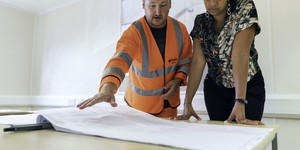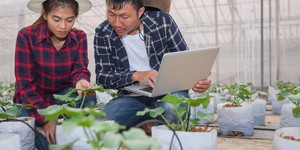Abstract
This project is inspired by the Banaue Rice Terraces, 2,000 year old structures carved into mountainsides in the Philippines. See if you can recreate the water flow of this ancient marvel, often called the Eighth Wonder of the World, using just household materials! Looking for inspiration? You can see how other students have tackled this and other annual Science Buddies Engineering Challenges.Summary
This engineering challenge is based on an internal competition designed by employees at Fluor Corporation.
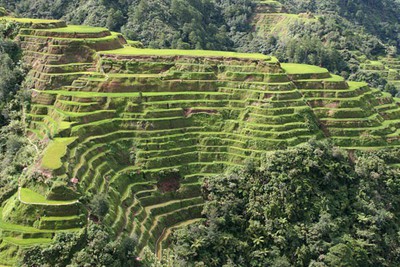
Objective
Build a model of a terraced irrigation system that uses flowing water to transport plastic beads. Beads start in the top layer and must flow through each lower layer until they are retained in the bottom layer.
Introduction
The Banaue Rice Terraces (Figure 1) are flat layers carved into the sides of mountains in the Philippines, which allow farmers to grow rice on the otherwise impossibly steep mountainsides. Amazingly, these structures are 2,000 years old—meaning they were made entirely by hand and without modern construction equipment!

Figure 1. One view of the Banaue Rice Terraces, an ancient engineering marvel in the Philippines.
The terraces were watered by an irrigation (the artificial application of water to plants for agriculture purposes) system that channeled water from mountain springs and streams down through the layers. This means the irrigation systems were powered entirely by gravity (the force that pulls things down towards the earth) as the water flowed down the mountainside.
In this project, your goal is to build a model of the Banaue Rice Terraces using some common household materials (Figure 2). You will design your terrace structure so plastic or wooden beads will be carried down from the top layer by running water, simulating the irrigation system in the real rice terraces. The beads are buoyant, meaning they float in water, because their density (mass per unit volume) is lower than the density of water. They get dragged along because water is viscous, meaning it exerts friction (a force that resists motion) when it flows past or around an object.
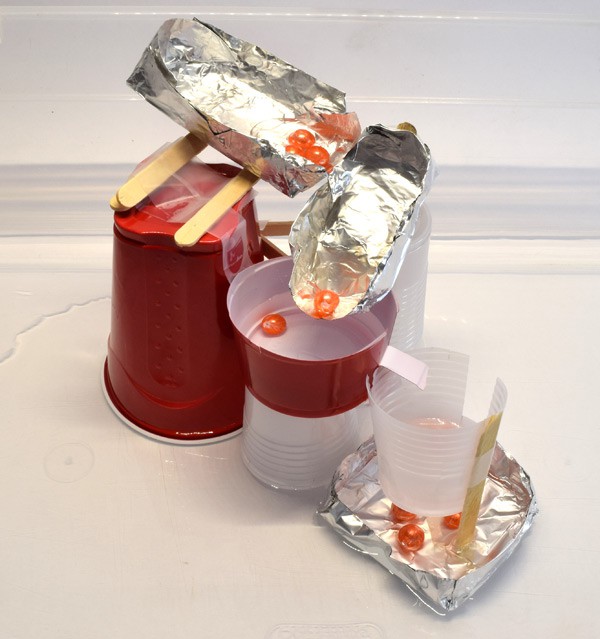 Image Credit: Ben Finio, Science Buddies / Science Buddies
Image Credit: Ben Finio, Science Buddies / Science Buddies
Figure 2. An example model of the Banaue Rice Terraces.
Designs entered in the 2017 Engineering Challenge had to be built using a limited list of materials and follow a specific set of rules. Move on to the Materials section to see the materials that are allowed if you want to compare your design to those in the contest. The rules are outlined in the Procedure. If you are just doing the activity for fun or for a science fair, you can choose your own materials.
Terms and Concepts
- Irrigation
- Gravity
- Buoyant
- Density
- Viscous
- Friction
Questions
- What purpose did the Banaue Rice Terraces serve?
- How were they irrigated without the use of electricity or modern equipmet?
- What determines if an object will float in water?
Bibliography
- Wikipedia Contributors (2016, September 5). Banaue Rice Terraces. Wikipedia.com. Retrieved October 31, 2016.
- Nave, R. (n.d.). Buoyancy. Hyperphysics. Retrieved November 1, 2016.
Materials and Equipment
- Designs entered in the 2017 Engineering Challenge (now closed) were limited to the following list of materials. Maximum allowable quantities are in parentheses. Scoring is explained in detail in the Procedure. If you want to compare your design to the high scores from the challenge, follow the same rules and scoring. Otherwise, use your own materials.
- Large (approx. 18 oz) paper or plastic cups (10)
- Small (approx. 9 oz) paper or plastic cups (20)
- Aluminum foil; cut a larger roll into pieces no larger than 10.75 by 12 inch sheets (27.3 cm by 30.5 cm) or buy pre-cut sheets from Amazon.com
- Popsicle sticks (50)
- Scotch® tape (1 roll)
- To test your machine, you will also need:
- Approx. 12 mm or 1/2 inch diameter wooden or plastic beads (10), available from Amazon.com or a craft store. The beads can have holes in them. Do not use glass marbles or metal bearings; they will sink!
- 1 liter (or 32 oz) plastic water bottle
- Tap water
- Metric ruler
- Large, shallow plastic tub to catch water if you are doing the project indoors, or an outdoor area where it is OK to spill water.
Disclaimer: Science Buddies participates in affiliate programs with Home Science Tools, Amazon.com, Carolina Biological, and Jameco Electronics. Proceeds from the affiliate programs help support Science Buddies, a 501(c)(3) public charity, and keep our resources free for everyone. Our top priority is student learning. If you have any comments (positive or negative) related to purchases you've made for science projects from recommendations on our site, please let us know. Write to us at scibuddy@sciencebuddies.org.
Experimental Procedure
Overview
The objective of the 2017 Engineering Challenge was to build a gravity-powered irrigation system modeled after the Banaue Rice Terraces in the Philippines. While the contest is over, you can still follow this procedure for a fun science fair project or classroom activity. Watch this video for a complete overview of the 2017 challenge:
Rules
Entries in the 2017 Engineering Challenge had to follow these rules. Entries that did not follow the rules were disqualified from winning prizes. You can follow the same rules if you want to compare your design to the high scores from the challenge.
- Your model can only be built from items listed in the Materials section. No other materials are allowed.
- There are no restrictions on the shape of your layers, and layers do not have to be the same shape. However, each layer must hold at least 1 cm of water at its deepest point (see Figure 3).
- Your model must have a minimum of 2 and a maximum of 10 layers.
- The bottom of each layer must be higher than the top of the next layer down (see Figure 3).
- All ten beads must start from rest in the top layer, with no water already in the model.
- You can only pour water into the topmost layer. There are no limits to how quickly or slowly you pour the water.
- You cannot touch the model or any of the beads during operation. However, there is no limit to the number of attempts you can use to try and get a high score. If your model breaks or does not behave as expected, you can reset it (pour out all the water and put the 10 beads back in the top layer) and start again.
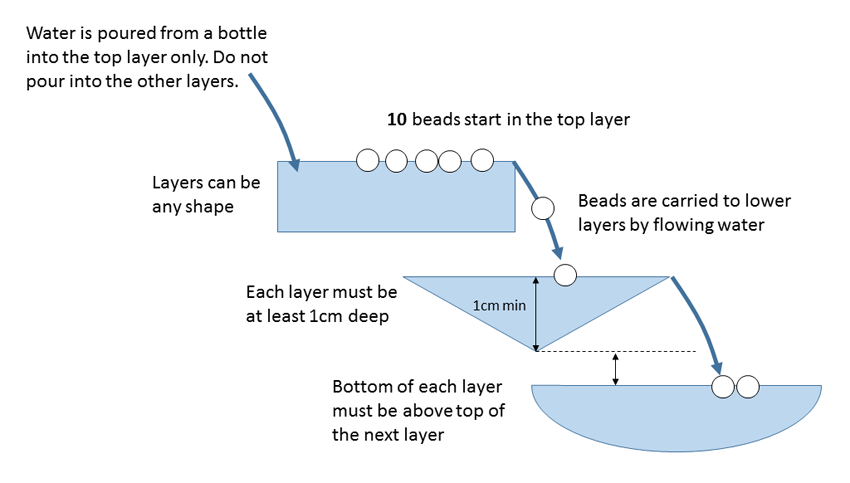 Image Credit: Ben Finio, Science Buddies / Science Buddies
Image Credit: Ben Finio, Science Buddies / Science BuddiesDiagram of irrigation system including three containers and ten beads. Water is poured into the top container, and as the water overflows, the beads follow and spill into a second (slightly lower) container. This continues for up to 10 layers of various shapes beneath the initial container.
Figure 3. Side view of an example terrace structure.
Scoring
Your total score is calculated using the equation:- Bead points: each bead is worth 100 points per layer that it moves down. See Figure 4.
- For example, a bead that moves from layer 0 to layer 2 (counting from the top, so the uppermost layer is layer 0) is worth 200 points because it moved two layers. This means that the more layers your structure has, the more points you can get.
- Beads that fall out of the model are not worth any points; even beads that roll out of the last layer.
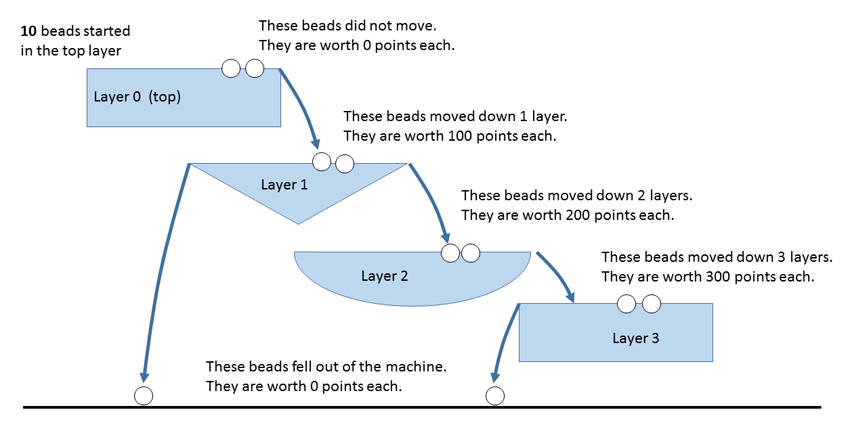 Image Credit: Ben Finio, Science Buddies / Science Buddies
Image Credit: Ben Finio, Science Buddies / Science BuddiesBeads move with water from a higher container to a lower container in order to score points. For each layer a bead moves down, its point value increase by 100. Beads that fall out of the containers are worth 0 points. The goal of the game is to score the most points possible.
Figure 4. Layer numbering and bead scoring.
- Materials points: each item in the materials list has a "point cost" assigned to it, summarized in Table 1. Since more points are awarded when beads move down more layers, this means there is a trade-off: building a taller structure with more layers can earn you more bead points, but will require more materials. Note:
- Only materials used in your final design count towards your score. Materials used during the testing and prototyping phase do not count.
- Point costs are not pro-rated. If you use any tape, you are charged the entire 100 points. If you cut a popsicle stick in half and only use half of it, it still costs 10 points. Each 10.75 by 12 piece of aluminum foil counts as one full sheet, even if you do not use the entire sheet.
| Item | Maximum Quantity | Point Cost (each) |
|---|---|---|
| Large plastic or paper cup (approx. 18 oz) | 10 | 100 |
| Small plastic or paper cup (approx 9 oz) | 20 | 50 |
| Aluminum foil, 10.75 by 12 inch (max) sheets | 20 | 50 |
| Popsicle sticks | 50 | 10 |
| Scotch® tape | 1 roll | 100 |
To calculate your score, you can use the equation above.
Testing Procedure
When building your model, you can test it and modify your design as many times as you would like. You can always re-test to try and get a higher score. There is no limit on the number of tests you can do, but you can only submit one score for the contest. When you are ready to do an official test to calculate your score, follow these steps:
- Drain all the water from your model.
- Place 10 plastic beads in the top layer of your model. Make sure they are not moving or rolling around at all before you continue.
- Fill a 1 liter (or 32 oz) plastic bottle with water.
- Pour the water into the top layer of your model.
- There are no limits for how quickly or slowly you must pour the water.
- You can only pour water into the top layer. Do not pour water into any of the other layers.
- You do not have to use all of the water, but you cannot refill the bottle.
- Wait until water has stopped flowing and all of the beads have stopped moving.
- Calculate your score using the "Scoring" section.
Tips for the Engineering Design Process
The Engineering Challenge is a good chance for students to learn about or practice the engineering design process. To use the engineering design process for this project, follow these steps:
- Define the problem: What is the problem you are trying to solve, or what objective are you trying to meet with this project? (Hint: The objective is defined for you pretty clearly in the Overview section).
- Do background research: Read the information in the Background section, check out the references in the the Bibliography, and do some additional research on your own.
- Specify requirements: Are there any specific requirements your model must meet (Hint: See the "Rules" section)? Are there any additional requirements you want to define? For example, "the model should use a minimal amount of materials" or "the model should be sturdy and not fall apart when you pour water into it." Write down all the requirements you can think of for your model.
- Brainstorm, evaluate, and choose a solution.
- Brainstorm: Think of different possible designs for models that you could build. Make sketches of the different designs, and make a list of materials that will be required to build them. Try to come up with at least three different designs.
- Evaluate: Compare your different designs. Which one do you think will satisfy your requirements the best? For example, does one model use fewer materials than the others? Does one look like it will be sturdier?
- Choose a solution: Pick one design based on your evaluation.
- Develop and prototype the solution: Build a prototype of your model, testing it out as you build. At this point, the engineering design process becomes iterative. That means you might need to go back to a previous step and start over from a certain point. For example, you might realize as you build your model that it is not sturdy enough, and you need to change your design. You might test your model by pouring just a little bit of water into it at a time, or placing the spheres in different starting locations to see where they flow easily and where they get stuck. It is okay if your model does not work perfectly on the first try. This happens all the time in real engineering.
- Test the solution: When you think your model is ready, do an official test run by following the steps in the "Testing Procedure" section. Calculate your score using the the "Scoring" section.
- Does the solution meet the requirements? Does your model follow all the rules of the contest? Does it meet any additional requirements that you set for yourself? How high is the score, and do you think you could do better? Continue brainstorming, prototyping, testing, and trying to improve your design until you are happy with your score.
- Communicate results: If you are doing this project as part of a class or club, then in addition to submitting your score to Science Buddies, prepare a brief presentation or demonstration to show the rest of the class how your model works.
Troubleshooting
For troubleshooting tips, please read our FAQ: Follow the Flow.
Ask an Expert
Global Connections
The United Nations Sustainable Development Goals (UNSDGs) are a blueprint to achieve a better and more sustainable future for all.
Variations
- Can you use your model to show how sediments are transported down the mountainside? What happens if you fill the top layer with dirt instead of using plastic beads? Can you see why erosion might be a problem for the rice terraces?
Frequently Asked Questions (FAQ)
Materials
Scoring
Careers
If you like this project, you might enjoy exploring these related careers:
Related Links
- Science Fair Project Guide
- Other Ideas Like This
- Civil Engineering Project Ideas
- Engineering Challenge Project Ideas
- My Favorites




